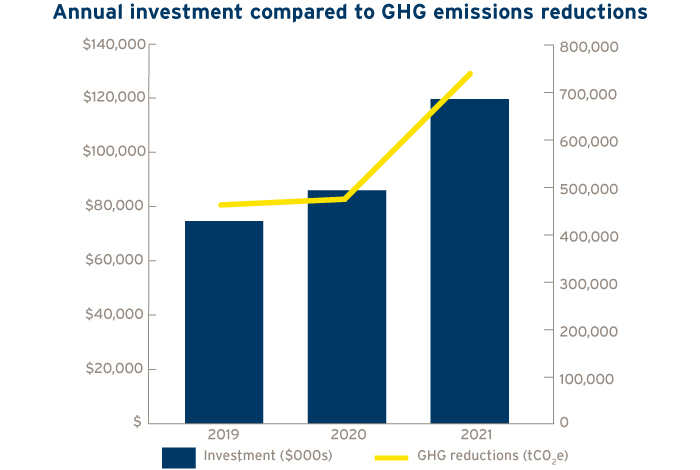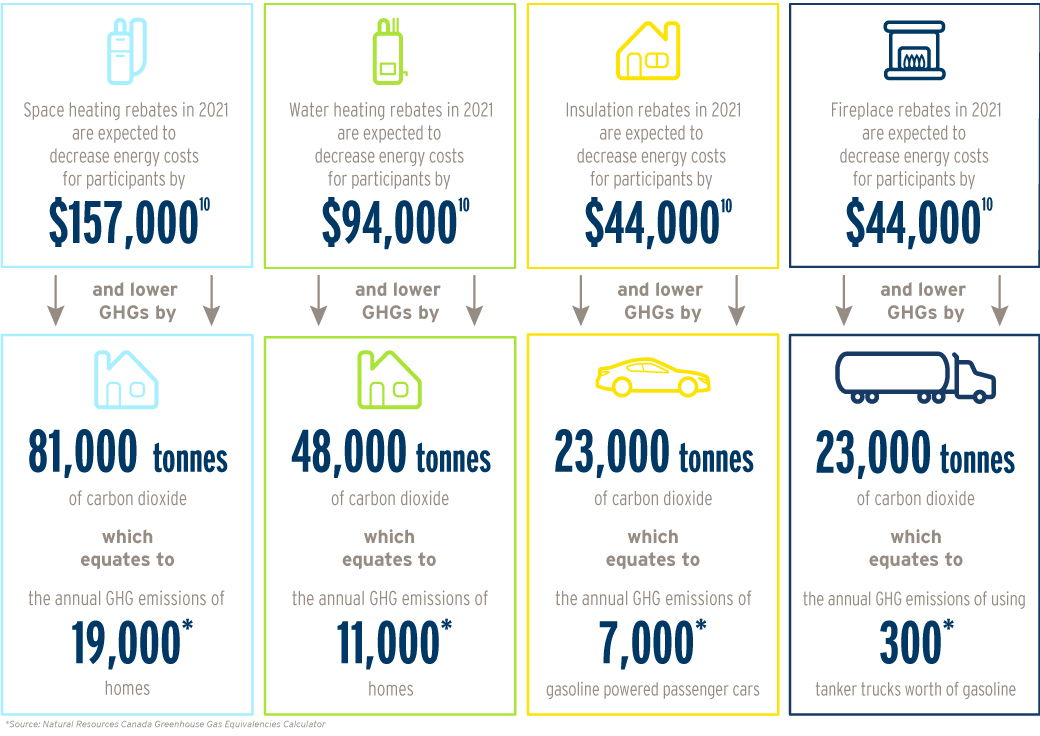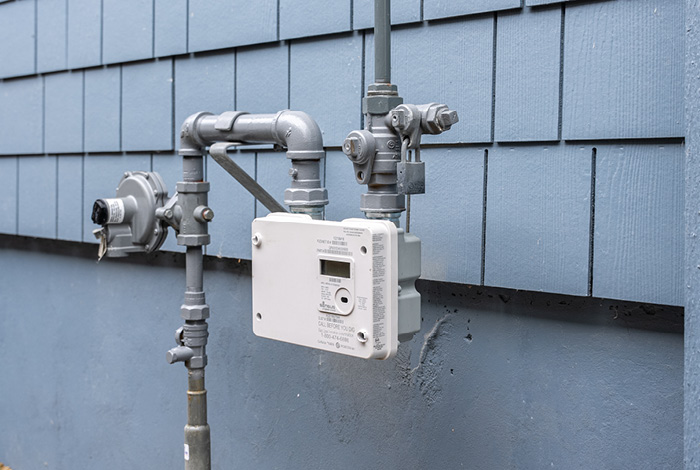See how record investment is paying off in energy savings
May 26, 2022
For both homes and businesses, we continue to see all types of customers do their part to prioritize energy savings and it’s paying off.
Last year, we invested close to $120 million1 in energy efficiency and conservation programs—a record breaking year for FortisBC and the largest investment in energy savings by a B.C. utility to date. It was also the second year in a row we surpassed our goal of achieving over a million gigajoules of annual energy savings2
And we’re not done yet—2021 was the third of a four-year plan to triple investment in energy savings programs. This year, we exceeded our 2018 investment in gas programs by more than 200 per cent.3
Leaving money in customers’ pockets
It’s paying off for customers, too. In 2021, customers who participated in these programs are conserving more than 1.1 million gigajoules of gas each year, the equivalent annual gas use of about 12,300 homes. In addition to this, our programs helped customers in the Southern Interior save enough electricity to power about 2,900 homes for a year.
This investment has also left money in customers’ pockets—in addition to getting cash back through rebates and incentives, customers who made these upgrades are expected to avoid an estimated $3.8 million4 in energy costs each year.
Investment is paying off in greenhouse gas (GHG) emissions reductions
Perhaps even more important is the avoided GHG emissions of these efforts. Over the life of the gas-saving measures, the 2021 rebate5 participants will decrease emissions by an estimated 736,000 tonnes of carbon dioxide equivalent (CO2e). For perspective, these savings are equivalent to a large-size SUV consuming close to five million tanks of gas.6,7
Together with the electricity-saving measures, our energy efficiency and conservation programs resulted in decreasing emissions by more than 750,000 tonnes of CO2e, the equivalent to removing almost 18,000 gas-powered cars—each with a lifespan of 12 years—from the road permanently.

FortisBC’s record investment in energy efficiency and conservation programs is paying off in reductions to GHG emissions (measured in tonnes of CO2e), over the life of the energy-efficiency upgrades.
Savings achieved by our residential customers
We were particularly encouraged to experience a record number of customers taking part in the Home Renovation Rebate Program5 last year, one of the busiest years we’ve had so far for our residential programs.
This program encourages homeowners to take a whole home approach to their energy-efficiency upgrades to improve their home’s overall performance and comfort.
In 2021, we provided close to 150,000 program-related rebates to our gas and electricity customers. For gas customers alone, that’s a 17 per cent increase over 2020. We also saw notable increases across our most popular rebate programs:5
- 56 per cent increase in the number of rebates for upgrades to high-efficiency natural gas furnaces
- 58 per cent increase in the number of rebates for insulation upgrades, and
- 28 per cent increase in rebates for high-efficiency water heating systems
The gas residential programs accounted for 26 per cent of the overall gigajoules savings in 2021, and the residential programs for our electricity customers (which includes lighting and other incentives in addition to the Home Renovation Rebate Program) achieved electricity savings of 7.9 gigawatt hours—a 10 per cent increase over 2020.
These savings are a significant achievement by homeowners, especially considering an individual homeowner’s budget and that the potential for energy savings would typically be much smaller than that of industrial and commercial customers operating larger facilities.
Collective actions add up
The pay off in cost savings and emissions reductions
is adding up. Here’s a look at some of the savings our customers have achieved
by participating in our most popular gas rebates in 2021, over the lifetime of
these upgrades.8

With the urgent need to reduce GHG emissions both locally and globally, we’re encouraged by these results. This is a significant accomplishment, yet we know that our efforts to introduce gas heat pumps, meet higher energy-efficiency building policies and advance even deeper levels of energy efficiency in our homes and businesses will decrease GHG emissions even more in the coming years.
Save more with rebates
If it’s time to upgrade your space and/or water heating equipment to high-efficiency equipment, or improve your home’s overall performance by adding insulation, we’ve got rebates on high-efficiency equipment and products to help make the upgrades more affordable.
Find out more about how you can get money back in rebates or take part in pilot projects that will help define the next generation of energy-efficiency rebates.
Together, we’re making a difference and that’s energy at work.
1 Source of savings figures: FortisBC Energy Inc. and FortisBC Inc. (collectively ‘FortisBC’) 2021 Annual Demand Side Management (DSM) Reports to the BC Utilities Commission. In 2021, FortisBC invested $106.8 million in programs and incentives for gas saving measures and $12.7 million in electricity saving measures.
2 FortisBC’s gas energy efficiency and conservation programs saved 1,032,721 annual gigajoules (GJ) in 2020 and 1,142,533 in 2021.
3 In 2018, FortisBC invested $35,472,000 and in 2021, $106,844,000, an increase of 201 per cent.
4 Based on estimated annual energy savings for electricity and gas savings measures installed in 2021 and rates over the same period; the per gigajoule rates and fees for natural gas as of July 2021 including delivery charge (5.024¢/GJ), carbon tax (2.3053¢/GJ), storage and transport fees (1.397¢/GJ) and cost of gas (2.844¢/GJ), and the Exempt Flat Rate (RS 03) for electricity customers, which was 12.383¢/kWh in 2021.
5 Some rebate programs have been updated. Some rebates and offers are no longer available.
6 Based on the measure’s lifetime GHG emissions reductions (tonnes CO2e). Emissions reduction value based on life cycle (well to burner tip) emission factor of 0.0598 tonnes CO2e/GJ for natural gas. Annual emissions reductions are just those attributed to the first year following the measure’s implementation. Lifetime reductions are the total reductions that occur over the life of all measures implemented (based on net present value of gas savings).
7 According the Natural Resources Canada, Greenhouse Gas Equivalency Calculator, one tonne of carbon emissions is equivalent to 426 litres of gasoline. Calculation assumes an SUV with a 65-litre gas tank.
8 Emissions reduction value based on life cycle (well to burner tip) emissions factor of 0.0598 tonnes CO2e/GJ for natural gas. Based on July 2021 per gigajoule rates and fees for natural gas including delivery charge (5.024¢/GJ), carbon tax (2.3053¢/GJ), storage and transport fees (1.397¢/GJ) and cost of gas (2.844¢/GJ). Emissions reduction equivalencies from Natural Resources Canada, Greenhouse Gas Equivalency Calculator.



